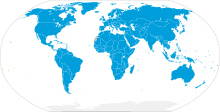
Back قائمة الدول الأعضاء في الأمم المتحدة Arabic BMT üzvü olan ölkələr Azerbaijani Дзяржавы — члены ААН Byelorussian Държави членки на ООН Bulgarian यूनाइटेड नेशंस के सदस्य देस Bihari Ol memba kaontri blong Yunaeted Nesen Bislama জাতিসংঘের সদস্যরাষ্ট্রসমূহ Bengali/Bangla Države članice Ujedinjenih nacija BS Estats membres de les Nacions Unides Catalan دەوڵەتانی ئەندامی نەتەوە یەکگرتووەکان CKB


The member states of the United Nations comprise 193 sovereign states. The United Nations (UN) is the world's largest intergovernmental organization. All members have equal representation in the UN General Assembly.[3]
The Charter of the United Nations defines the rules for admission of member states. Membership is open to all states which accept certain terms of the charter and are able to carry them out. New members must be recommended by the United Nations Security Council. In addition to the member states, the UN also invites non-member states to be observer states at the UN General Assembly. A member state that has persistently violated the principles of the United Nations Charter can be expelled from the United Nations.[4]
Cite error: There are <ref group=lower-alpha> tags or {{efn}} templates on this page, but the references will not show without a {{reflist|group=lower-alpha}} template or {{notelist}} template (see the help page).
- ^ "UN: "Data for 197 countries: all 193 member states, two observer states (the Holy See and Palestine), and two non-member states (Cook Islands and Niue)"" (PDF). UN.org. Retrieved 28 April 2023.
- ^ "United Nations - The World Today". UN.org. 1 September 2019. Retrieved 28 April 2023.
- ^ "What are Member States?". United Nations.
- ^ "Frequently asked questions". United Nations Office at Vienna. Retrieved 17 December 2023.